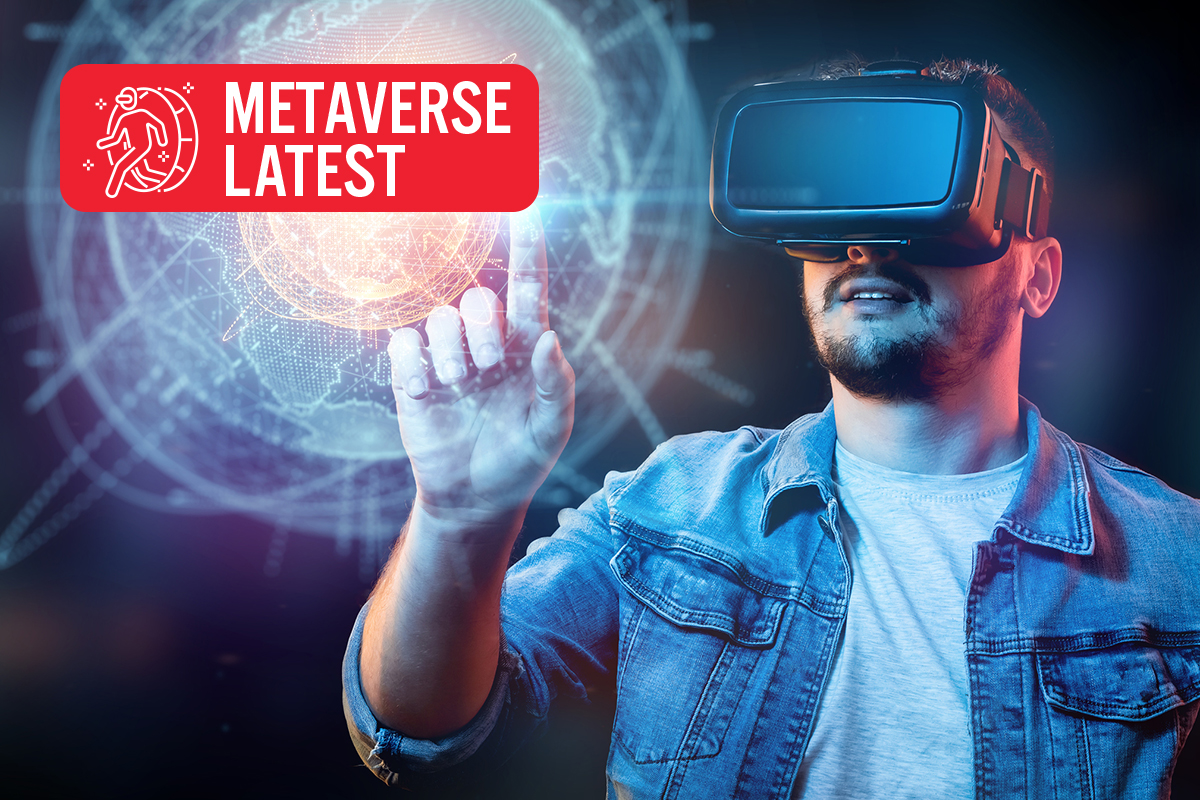
albert Chan
Metaverse Latest
Metaverse technologies and virtual gaming have surged in popularity during the Covid-19 pandemic and are continuing to evolve, grow and converge each month. Coresight Research has identified the expanding metaverse as a key trend to watch in global retail in 2022 and beyond.
Our Metaverse Latest series provides regular updates on metaverse developments, showing how key players and new entrants are seizing opportunities in the space. We also discuss three metaverse trends we have seen recently. In this report, we present developments as of March 8, 2022.
Recent Metaverse Developments
- On February 22, 2022, Italian fashion brand Benetton participated in Milan’s Fashion Week to reveal its digital retail plans of transforming its flagship store into a fully immersive mixed-reality experience available in the metaverse.
- On February 22, 2022, Sony unveiled the design of its next generation of VR2 headsets for PlayStation. The advancements feature a lens adjustment dial, reductions in weight and new vent designs. The headsets also support feedback from haptic and facial tracking sensors as well as improved frame rates.
- On February 23, 2022, Meta CEO Mark Zuckerberg announced several new AI (artificial intelligence)-based projects to power the metaverse, including Builder Bot, an AI designed to create virtual worlds. He said that Meta plans to develop a universal translator for avatars from different parts of the world to communicate instantaneously.
- On February 24, 2022, telecommunications company AT&T announced a partnership with Microsoft to develop a new 5G edge computing ecosystem that integrates its 5G network with Microsoft Azure’s cloud network. Microsoft is vertically integrated and investing heavily in metaverse technologies—the company is developing its Mesh solution for augmented collaboration in the workplace, and it recently acquired video-game company Activision Blizzard.
- On February 25, 2022, automobile manufacturer Kia partnered with Wave, the metaverse’s first DJ to exist exclusively as a virtual idol, to position itself as a brand that unleashes creativity. Wave is set to interact with customers and fans through VR (virtual reality) headsets, and Kia is also releasing digital clothing for avatars.
- On February 26, 2022, luxury fashion house Dolce & Gabbana stitched a virtual catwalk together with its real one at Milan Fashion Week. Avatars sporting pixelated clothing collections seamlessly transitioned into real-world models on the catwalk.
- On February 27, 2022, headset provider HTC revealed its vision of the metaverse, Viverse, accessed through its Vive headset. The company envisions a safe and secure world for adults and children to customize, collaborate in, and have fun in. HTC also released the Reign Foundation, a portable and private 5G network.
- On February 27, 2022, blockchain project Evmos announced a major plan to merge the Ethereum and Cosmos chains, representing a big step toward cross-chain communication and interoperability with two of the more active platforms.
- On February 28, 2022, Japanese consumer electronics retailer Rakuten launched a new NFT (non-fungible token—non-exchangeable units of data stored on the blockchain) and sales platform in areas such as sports, entertainment and music. The platform allows for creators to build their own websites to properly showcase their NFT collections.
- On February 28, 2022, the South Korean Ministry of ICT and Science, a government institution, pledged to invest $187 million in the development of a new metaverse platform, Expanded Virtual World.
- On March 1, 2022, semiconductor giant Qualcomm demonstrated its Snapdragon X70 Modem, which uses AI and machine learning technology to provide “breakthrough 5G speeds, coverage, low latency.” According to Qualcomm, the technology solution is the world’s fastest 5G processor, which will provide a big boost for metaverse frame rates and connection.
- On March 1, 2022, rapper Doja Cat announced a partnership with Eek! Games to create a digital avatar of herself in a new game, House Party. Players can enjoy an immersive party room and several character storylines, as well as interact with Doja Car’s avatar in a number of ways—befriending her, flirting with her and even “falling in love.”
- On March 1, 2022, Spanish telecommunications company Telefónica Madrid announced a collaboration with Meta Platforms to explore and expand and metaverse technologies and networks. The partnership also will also create the Metaverse Innovation Hub, “aimed at network testing, infrastructure and technological innovation for startups and developers.”
- On March 2, 2022, in partnership with Fox Entertainment’s blockchain, Creative Labs, Dolly Parton unveiled her metaverse, Dollyverse. She will release a book and an album as NFTs.
- On March 3, 2022, fast-food giant Wingstop filed a trademark to sell its chicken in the metaverse. The trademark covers virtual food and beverages and “downloadable virtual goods” as NFTs.
- On March 3, 2022, Chinese-based technology conglomerate Tencent filed patents related to virtual converts in the metaverse. Tencent’s first metaverse concert in China on December 31, 2021, drew an audience of 1.1 million. Tencent has also acquired extended-reality entertainment platform Wave, which uses motion-capture technology for artists to control their avatars.
- On March 3, 2022, The Sandbox surpassed 2 million total users. Releasing its Alpha Season 2 version of the game, which received very strong feedback from beta testers, the metaverse platform expects to attract over 200,000 new visitors.
- On March 3, 2022, in a milestone for cryptocurrency adoption, digital coin Tether announced via Twitter that it had partnered with the Swiss city of Lugano to establish Bitcoin and Lugano’s own LVGA tokens as legal tender in the city.
- On March 4, 2022, retailer CVS announced that it had filed trademarks for “downloadable virtual goods,” including wellness products, other merchandise represented as NFTs and a VR pharmacy for virtual prescriptions.
- On March 4, 2022, Naver, creator of South Korean-based metaverse platform Zepeto announced that its domestic and international user base had grown to 300 million total users, with international users accounting for 95%.
- On March 4, 2022, Verizon revealed its partnership with Meta to explore how the 5G-powered metaverse will enable new ways to connect during work and play, and the build the necessary infrastructure to make 5G-powered use cases possible.
- On March 7, 2022, the first Layer 2 solution for high-volume Ethereum NFT trades and transactions, Immutable X, raised $200 million from Tencent and Animoca Brands (which owns The Sandbox). Immutable will use the money to expand globally and develop its blockchain gaming ecosystem.
- On March 8, 2022, Layer 2 Ethereum solution Polygon adds DraftKings, a publicly traded sports betting company as a network validator on its network—verifying the authenticity and validity of transactions on the blockchain exchange. This is the first example of a public company taking an active role in blockchain governance.
Three Trends We’ve Seen Recently
1. Solutions Are Emerging to Support the High-Volume NFT Trade
As NFT transaction volume has recently surged (amid the Covid-19 pandemic and heavy investments into metaverse-related technologies), the number of Layer 2 platforms being developed and released to support high-volume NFT trade at multiple price points has also skyrocketed.
The blockchain comprises the following three layers:
- Layer 1—The underlying blockchain architect, the first or original platform, such as the Ethereum or Bitcoin Mainnet (primary public blockchain)
- Layer 2—Scaling solutions and protocols that are built on top of Layer 1 infrastructure, often utilizing off-chain transactions to improve speed, efficiency and cost
- Layer 3—Blockchain-based applications and games (virtual worlds) that feature cross-chain implementation for different Mainnet blockchains to send and receive data
Layer 2 platforms offer brands diverse options to begin minting and selling digital product collections and leveraging blockchain technology to take advantage of its improvements over centralized finance in speed and verification. To support high-volume NFT trade, developers have created 19 notable Layer 2 protocols as of January 2022, with more being announced on a weekly basis, according to Yahoo News.
The average number of primary NFT sales (from NFT creator/minter to first purchaser) as well as the average number of active market wallets (unique cryptocurrency wallets) continue their staggering rises, per NFT data aggregator NonFungible (see Figures 1 and 2).
Figure 1. All-Time Average Primary NFT Sales (Mil.)
[caption id="attachment_143158" align="alignnone" width="700"]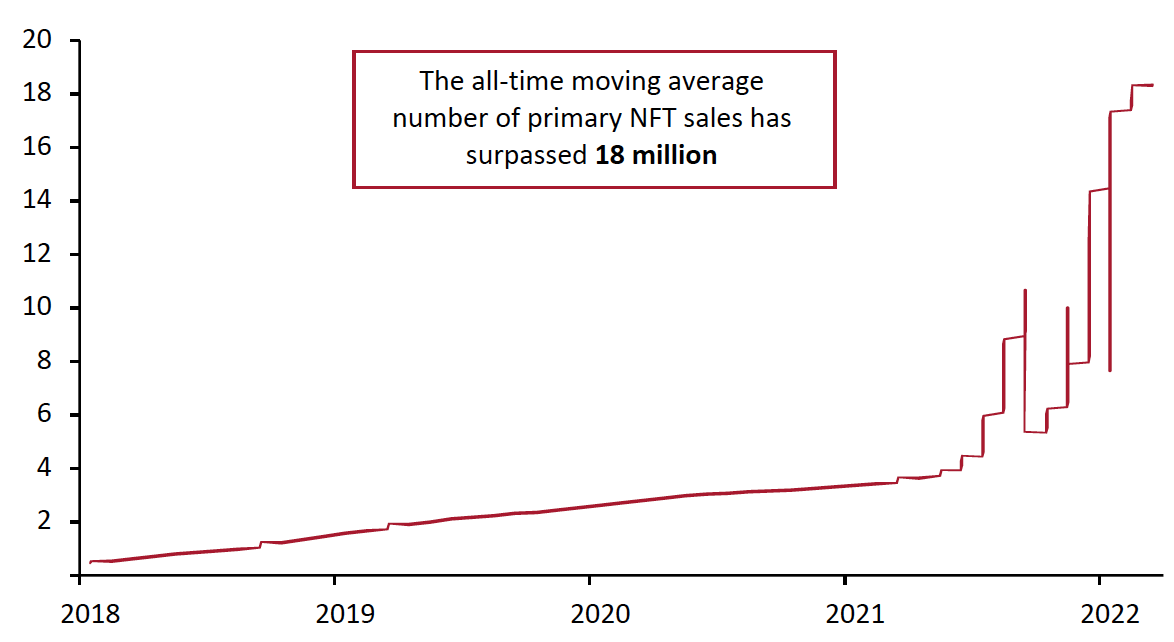 As of March 8, 2022
As of March 8, 2022Source: NonFungible[/caption]
Figure 2. Number of Unique Cryptocurrency Wallets (Thous.)
[caption id="attachment_143159" align="alignnone" width="700"]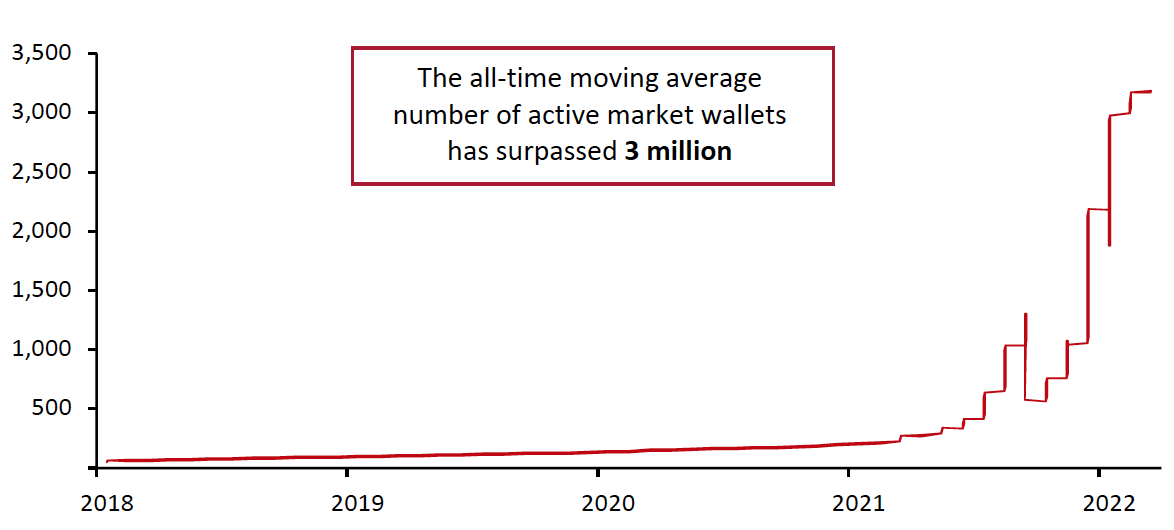 As of March 8, 2022
As of March 8, 2022Source: NonFungible[/caption]
As NFTs continue to surge in popularity, large Layer 1 blockchain platforms such as Ethereum are struggling to keep up with the volume, and platforms built on Ethereum that have not partnered with any scaling solutions face a trilemma, in which they sacrifice one of decentralization (lack of third-party, instant transactions), scalability (for higher volume) or security (verification of ownership) for the other two.
With higher transaction volumes, Layer 1 solutions also struggle with congestion (too many transactions per block) leading to higher gas fees—“royalty” fees paid to miners of currency tokens and NFTs. Gas fees can vary by time of day and week, and if high, can discourage low-value NFT transactions and stifle activity within the NFT market.
To combat these issues, Layer 2 Platforms, extensions of the Mainnet blockchains, are developing sidechains—separate blockchains running parallel to the main blockchain—and alternate mechanisms for processing transactions which require less energy.
With all these new solutions and technologies being developed, gas fees and network congestion, as well as environmental concerns, can be alleviated—and NFT marketplaces and trade within virtual economies will be free to thrive.
2. Brands Are Entering Partnerships To Launch NFT Collections
Brands are beginning to form partnerships with blockchain-related projects, NFT marketplaces and virtual games to mint and sell NFT collections. As NFTs can represent any virtual asset, or even physical assets, they will soon become the backbone of in-game economies for virtual worlds based on a blockchain, meaning that transactions within the metaverse will be instant, and ownership will be protected and secured across the blockchain. Without incurring delays or transaction costs from third parties, virtual economies are free to flourish. Customers can also be sure they are not being fleeced, as their ownership is protected and they can view all transaction history of an NFT, increasing the authenticity of the digital asset it represents.
Because of their features and underlying technologies, NFTs will also be crucial for protecting uniqueness. Many virtual worlds exist, but they will eventually be interoperable, meaning that users can take their digital assets—whether they be apparel, accessories or their avatar—with them as they travel from world to world.
Sportswear retailer NIKE recently acquired RTFKT, an NFT digital sneaker company that minted CloneX NFT avatars for users to have as digital personas across the metaverse. The collection has generated over $450 million in all-time (initial purchase and secondary) sales and is one of the highest selling NFT collections to date, according to CryptoSlam.
[caption id="attachment_143160" align="alignnone" width="350"] An example of a CloneX NFT avatar
An example of a CloneX NFT avatarSource: OpenSea[/caption]
Brands are making use of NFTs by offering limited-edition collections; because they are non-exchangeable and scarce, and because ownership is verified on the blockchain, these collections have sold for millions of dollars. Luxury fashion retailer Dolce & Gabbana, for example, minted its nine-piece Collezione Genesi collection of NFT clothing, which sold at auction for $5.6 million.
[caption id="attachment_143161" align="alignnone" width="350"]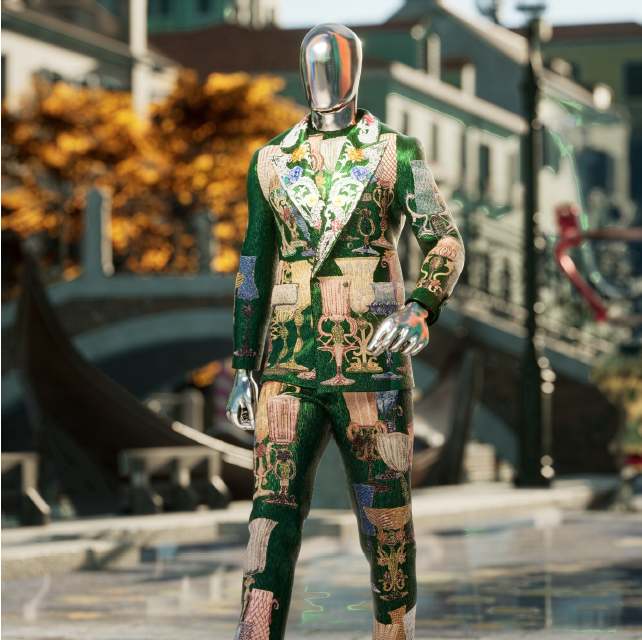 A piece from D&G’s Collezione Genesi collection
A piece from D&G’s Collezione Genesi collectionSource: New York Times[/caption]
Although scarcity drives demand and pushes prices up, brands have also started generating sales within virtual games by selling lower-value NFTs. For example, luxury retailer Burberry partnered with Mythical Games to release four limited-edition NFT collections in the Blankos Block Party game, priced at $300, $100, $50 and $25.
[caption id="attachment_143162" align="alignnone" width="350"]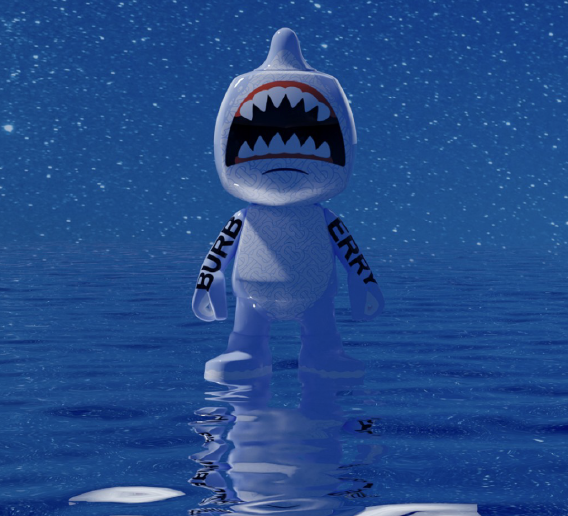 Burberry’s limited-edition NFT character, ‘Sharky B’
Burberry’s limited-edition NFT character, ‘Sharky B’Source: Burberry[/caption]
NFTs have complex underlying technologies, but they are crucial building blocks of the metaverse for protecting ownership and distinctiveness across virtual worlds, as well as offering security and verification for transactions. Unique, non-interchangeable and traded on an indelible record of transactions (the blockchain), NFTs can represent all digital, and even some physical, assets, providing protection of ownership and authenticity unlike in the physical world of centralized finance and third parties.
3. Brands Are Building Immersive Community Experiences
Investors are partnering with virtual worlds and purchasing virtual real estate to develop themed neighborhoods and districts for avatars with different tastes and interests. In these neighborhoods, brands have the opportunity to create immersive shared experiences for customers and build a strong community. Avatars from all parts of the world are likely to explore areas that suit their interest, and as more people build their digital personas in the metaverse, digital footfall, even for niche hobbies and interests, could be higher than real-world has traffic ever been.
The Sandbox and Decentraland have both partnered with several brands to create immersive communities and environments for users. Blockchain projects and virtual real estate companies have also spent millions in both worlds to purchase and develop land parcels to build themed worlds for commercial use.
Below, we explore notable examples of brands building communities in virtual gaming platforms.
Snoopverse
Rapper Snoop Dogg purchased a plot of land in The Sandbox, dubbed “Snoopverse,” where he will interact with fans, sell NFT merchandise and perform virtual concerts. He also worked with the platform to personally design avatars and NFT “doggies,” a collection of 10,000 virtual Snoop Doggs that are playable in The Sandbox.
Anticipating the district to be a highly coveted and trafficked, an NFT collector purchased a $450,000 plot of land in the neighborhood.
Nikeland
Other than its purchase of RTFKT, NIKE has also collaborated with virtual gaming platform Roblox to create “Nikeland,” an immersive experience modeled after its headquarters where visitors can play games, personalize looks and enjoy experiences not possible in a physical setting.
[caption id="attachment_143163" align="alignnone" width="550"]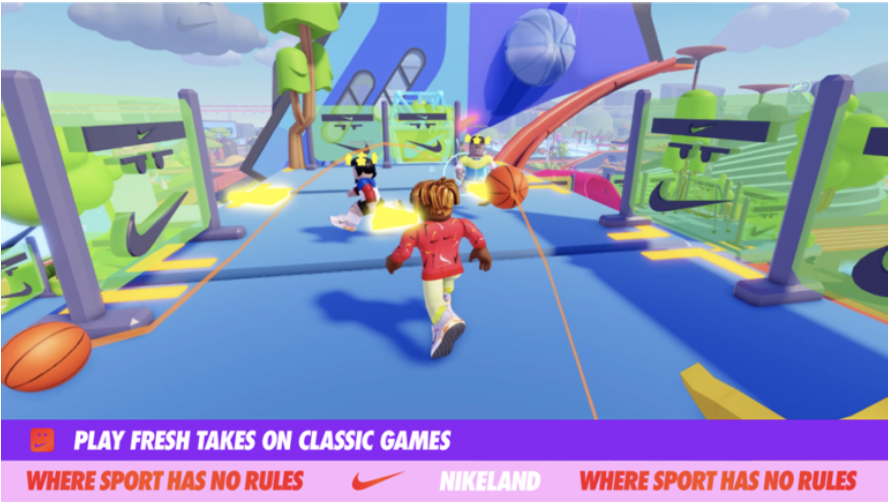 Users playing basketball in Nikeland
Users playing basketball in NikelandSource: Roblox[/caption]
In the experience, users can play immersive sports games that could be considered otherwise dangerous in the real world, such as “Tag” on trampolines or “The Floor is Lava” with parkour. Avatars in the environment also have access to super powers. In the showroom, users can customize their avatars with the latest collection of NIKE apparel.
Warner Music
In February, Warner Music Group announced a partnership with The Sandbox, receiving an entire beachfront estate (land NFT comprising multiple parcels) to develop a themed music district. As one of the first music brands to enter the metaverse, Warner Music plans to develop interactive social music experiences that defy real-world laws of physics.
As part of the agreement, The Sandbox also expects that Warner Music Group will work with the platform to create digital avatars of its musical artists to perform virtual concerts for Sandbox avatars to enjoy. The collaboration should also bring a larger user base to the platform, as fans will have the opportunity to interact with celebrities.
[caption id="attachment_143164" align="alignnone" width="550"]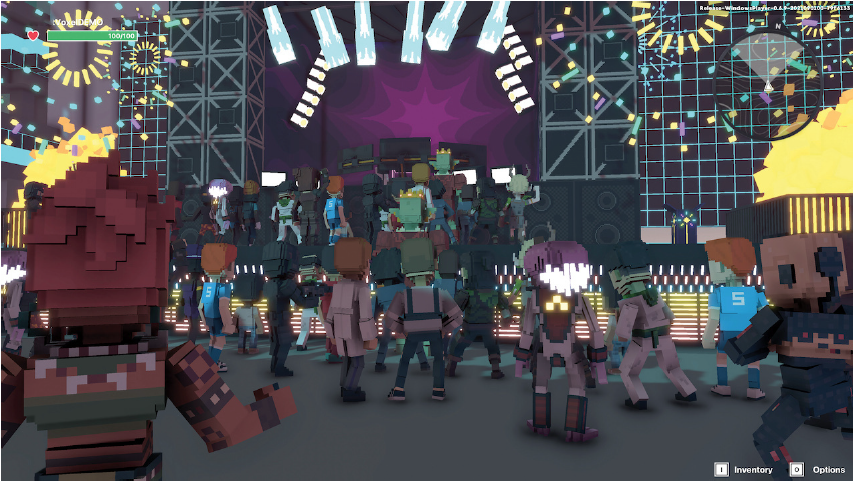 Depiction of a virtual concert in Warner Music’s metaverse
Depiction of a virtual concert in Warner Music’s metaverseSource: PCMag[/caption]
What We Think
We believe that NFTs will be the backbone of the metaverse, and will eventually come to represent even physical world assets. As opposed to today’s world of centralized finance, trading assets on a blockchain improves security, verification and authenticity. NFTs also help to protect distinctiveness and ownership, laying the foundation for working economies based off of digital asset trade.
However, popular blockchains such as Ethereum, where most NFT transactions occur, have less developed technology and struggle to balance decentralization, scalability and security while managing gas fees. Layer 2 protocols address these issues and so help unlock thriving virtual and in-world economies. Although NFTs are complex, it will become increasingly important for retailers to consider related strategies as transaction volumes continue to climb.
As blockchain worlds grow in popularity, brands and retailers are beginning to create immersive community experiences. Because the metaverse can be accessed by anyone, from anywhere, interests with small followings will gain larger global followings—and brands, more so than they are doing now, will begin to build themed experiences in relevant districts for commercial opportunities.